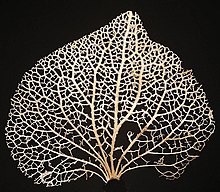
Back مفاغرة Arabic Анастамоз Byelorussian Anastomoza BS Anastomosi Catalan Anastomóza Czech Αναστόμωση Greek Anastomozo Esperanto Anastomosis Spanish بازپیوندی Persian Anastomoosi Finnish

An anastomosis (/əˌnæstəˈmoʊsɪs/, pl.: anastomoses) is a connection or opening between two things (especially cavities or passages) that are normally diverging or branching, such as between blood vessels, leaf veins, or streams. Such a connection may be normal (such as the foramen ovale in a fetus' heart) or abnormal (such as the patent foramen ovale in an adult's heart); it may be acquired (such as an arteriovenous fistula) or innate (such as the arteriovenous shunt of a metarteriole); and it may be natural (such as the aforementioned examples) or artificial (such as a surgical anastomosis). The reestablishment of an anastomosis that had become blocked is called a reanastomosis. Anastomoses that are abnormal, whether congenital or acquired, are often called fistulas.
The term is used in medicine,[1] biology, mycology, geology, and geography.
- ^ "Online ICD9/ICD9CM codes". icd9cm.chrisendres.com. Retrieved 2022-01-24.